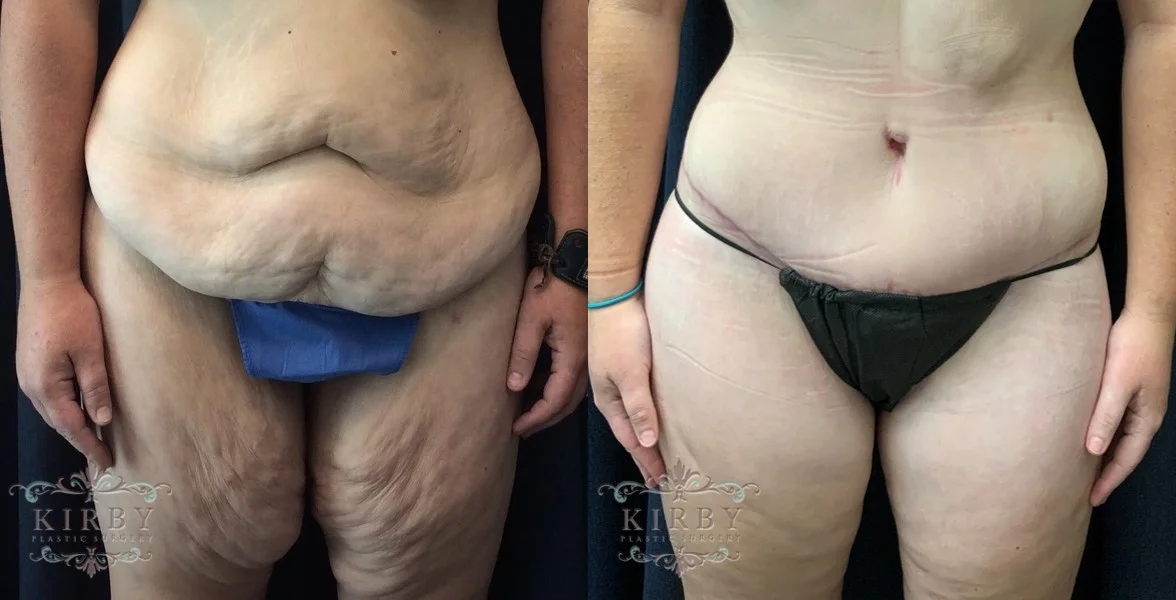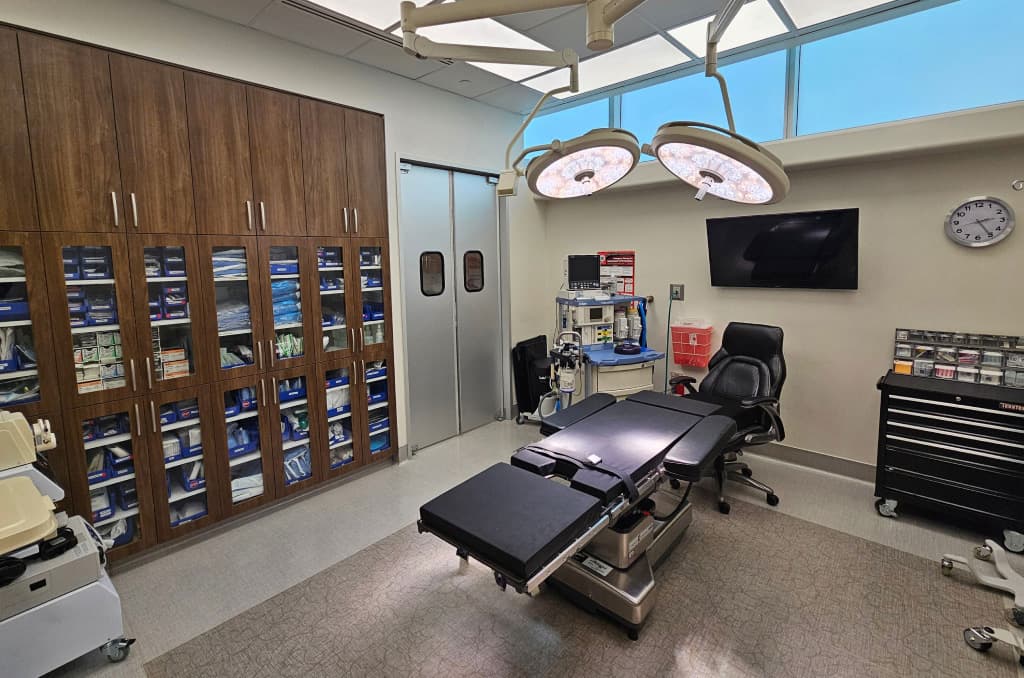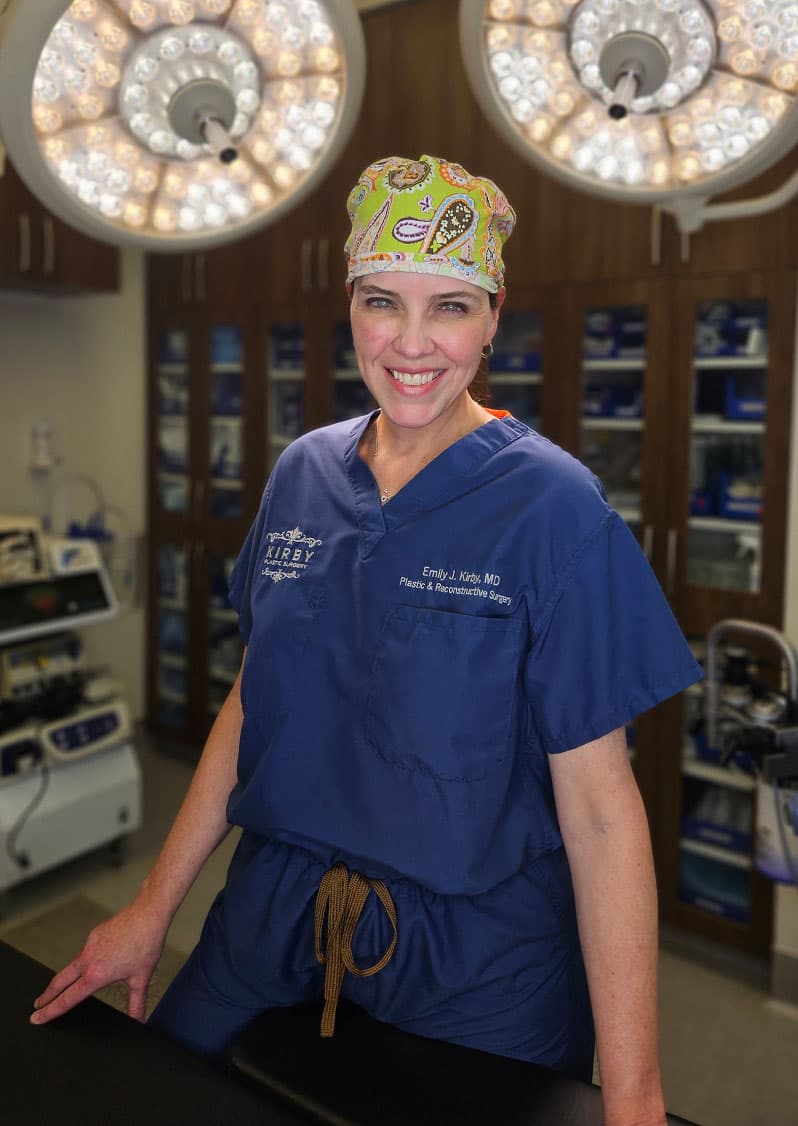Body Contouring After Weight Loss Fort Worth

Body contouring is a broad term referring to a variety of cosmetic procedures that help to shape your body. Whether you have recently lost a significant amount of weight from bariatric surgery, GLP-1 medications (semaglutide or tirzepatide), an effective diet and exercise routine, or after pregnancy, body contouring effectively removes stretched skin and tightens muscles affected by your weight changes. Fort Worth plastic surgeon Dr. Emily J. Kirby has helped hundreds of patients feel confident and beautiful in their bodies with the help of body contouring procedures.
Am I a good candidate for body contouring?
If you have recently undergone weight loss (defined as 50% or more of your excess weight), you are committed to keeping your weight off, and you have excess skin and/or fat leftover, you may benefit from body contouring procedures.
Real patient images from Board-Certified Plastic Surgeon Dr. Emily Kirby
*Individual results may vary.

Managing excess skin after weight loss surgery (bariatric surgery)
Body contouring procedures (such as post-bariatric abdominoplasty) can help if you are left with excess skin after bariatric surgery. We see post-bariatric surgery patients who have undergone gastric bypass surgery and gastric sleeve surgery, among other weight loss procedures.
Body contouring after weight loss with semaglutide-type GLP-1 medications
Patients also come to us for excess skin removal after losing weight with prescriptions like semaglutide and tirzepatide (often referred to as the brand names Wegovy, Mounjaro, Zepbound, or Ozempic). The plastic surgeries explained below can help to further enhance your body’s contours and provide a sense of completion to your weight loss journey.
Female Plastic Surgeon Fort Worth
- Board-Certified Plastic Surgeon
- Over 14 years of experience in private practice
- Founder and Medical Director of Kirby Plastic Surgery, Kalos Medical Spa, and City Surgery Center—a Quad A-accredited, state-of-the-art facility located onsite
- Specialist in breast surgery and body contouring, including postpartum
- Castle Connolly Top Doctor since 2019
- First female Chief of Plastic Surgery, Texas Health Resources Harris Methodist Hospital
Why should you consider body contouring after weight loss?
There are many reasons to consider body contouring after undergoing weight loss:
- Tone. Body contouring procedures are meant to enhance your body’s natural features, not completely change your physique. By reducing extra skin and fat, body contouring can reveal your natural muscle tone and curves.
- Hygiene. Removing excess skin can stop problems with rashes and infection in the folds of your skin that are caused by bacteria accumulating there.
- Weight. Though body contouring cannot keep you from gaining weight, it allows you to see the continued benefits of your new diet and exercise routine. It is much easier to see results from weight loss and stay motivated to keep weight off when you are close to your ideal weight.
- Shape. Once you have shed your extra weight, you can fully appreciate your enhanced look with a number of body contouring procedures. Body contouring can help you see the full results from your weight loss by removing excess skin and fat that may still be clinging to your body.
GLP-1s & Body Contouring After Weight Loss: What you need to know
A large percentage of our Fort Worth plastic surgery patients seeking body contouring procedures have achieved significant weight loss with the help of semaglutide or tirzepatide medications such as Ozempic®, Wegovy®, Rybelsus®, or Mounjaro®. For patients taking weight loss medication, Dr. Kirby designs the ideal surgery plan once you reach a stable, healthy weight you feel great about and are no longer on the medication. The timing of your surgery is important, as undergoing a body contouring procedure before your weight loss is complete can weaken your initial results. You will need to stop taking GLP-1 medication about 2-3 weeks before surgery to avoid anesthesia complications.
What procedures can address excess skin after weight loss?
If you have recently lost a significant amount of weight from bariatric surgery, GLP-1 medications (semaglutide or tirzepatide), an effective diet and exercise routine, or after pregnancy, you are likely dealing with lose, excess skin. In this video, Dr. Kirby explains your options for excess skin removal after weight loss to help you fully enjoy your new figure.
Body contouring procedures in Fort Worth
At Kirby Plastic Surgery in Fort Worth, Texas, we offer a variety of body contouring procedures to help you look and feel your best following your weight loss:
Arm Lift
Brachioplasty, also called an arm lift, removes excess skin and fat from your upper arm through an incision along your inner arm and/or armpit (“axillary”) area. Brachioplasty is recommended for patients with “flabby,” loose upper arm tissue, including the armpit region. If you have recently experienced weight loss and have stubborn arm skin (“bat wings”), an arm lift is an ideal procedure to smooth and shape your upper arms.
Recovery: You may return to work and light activity within a week following your arm lift procedure, and should be able to engage in full physical activity after about 6 weeks.
Thigh Lift
Thighplasty, also called a thigh lift, removes excess skin and fat in the thighs. Thighplasty provides a more proportional and contoured appearance to the thighs and lower body. A thigh lift can reduce the chafing and skin irritation patients often experience in their inner thighs following major weight loss. This procedure is performed under general anesthesia, and some scars can be hidden in your lower body’s natural creases.
Recovery: You can return to work and light activity within 7-10 days after your thigh lift, and can resume full physical activity after about 6 weeks.
Liposuction
Lipoplasty, or liposuction, is extremely effective at getting rid of pesky fat that is unresponsive to exercise or diet. When fat cells are removed, they do not regenerate from where the liposuction was performed, making it a permanent fat loss solution (though your remaining fat cells around the liposuctioned area can still enlarge and shrink). Liposuction may be used on its own to target fat in certain areas of your body following your weight loss, or it may be utilized along with other body contouring procedures.
Recovery: You should expect to be able to return to work and light activity within days of your liposuction, and any soreness should dissipate after 2 weeks.
Tummy Tuck
After losing a significant amount of weight, you may still have skin and fat hanging over your groin, hips, or back, hiding your newly-slim waist. Abdominoplasty, also called a tummy tuck, tightens your abdominal muscles and removes excess skin in the belly and groin to slim your abdomen and restore the balance of your core. Tummy tucks can also remove stretch marks if they are located on skin that will be removed during your procedure.
To help patients get back to normal activities quickly, Dr. Kirby now offers tummy tuck surgery with a TAP block.
Recovery: You will need to keep a slightly flexed position at the waist (walking slightly hunched over) for 2 weeks after your surgery and avoid lifting anything over 10 pounds for 4-6 weeks. Depending on the extent of skin and fat removed, it may take a few months to fully recover from your abdominoplasty.
Fleur-de-lis abdominoplasty
A fleur-de-lis abdominoplasty is performed similarly to the traditional tummy tuck, but with an added vertical incision down the abdomen, allowing Dr. Kirby to remove more tissue from the trunk. The relaxed abdominal muscles are still tightened using this approach. This option is ideal for someone who already has a midline abdominal scar or for someone who has significant excess tissue and does not desire a 360 body lift.
Recovery: Recovery is the same as a tummy tuck.
Circumferential Body Lift
A circumferential body lift combines a lower body lift and a 360 body lift to remove excess skin, fat, and soft tissue from the abdomen, flanks, and back. It is commonly performed in patients who have lost a great deal of weight but lack adequate skin elasticity.
Recovery: You should resume light walking as soon as possible following your surgery to minimize the potential for blood clotting and to increase blood flow to your tissues. You may resume normal exercises 6-8 weeks following your surgery. Most patients return to work in 2 weeks.
Your personalized consultation with Dr. Kirby
Your consultation takes about one hour. You’ll spend most of that time with Dr. Kirby discussing your goals, concerns, and questions, and learning how Dr. Kirby tailors the procedure to address each of these. You’ll also get to meet our nursing staff who will take your vitals and review your medical history, and our patient care coordinator will schedule your procedure and help guide you through the process from start to finish.
- Key Benefits
- Glossary
- Improves comfort and mobility by removing excess skin
- Reduces chafing and skin infections
- Facilitates a more active lifestyle
- Customized where you need it, such as in the arms, thighs, and hips
- May offer a sense of closure to your weight loss journey
- Abdominoplasty (Tummy Tuck): A surgical procedure that removes excess skin and fat from the abdomen and tightens the abdominal muscles, often a key component of body contouring after weight loss.
- Bariatric Surgery: Medical procedures performed on the stomach or intestines to induce weight loss, often the precursor to body contouring surgeries by significantly reducing body weight and volume.
- Body Contouring: A series of surgical procedures aimed at removing excess skin and fat to improve the shape and tone of the underlying tissue, typically performed after significant weight loss.
- Brachioplasty (Arm Lift): A procedure to remove excess skin and fat from the upper arms, creating a more toned and contoured appearance.
- Buttock Lift: A surgery that lifts and tightens the skin around the buttocks, often combined with augmentation procedures to enhance the buttocks’ shape.
- Circumferential Body Lift: Also known as a lower body lift, this procedure targets the abdomen, buttocks, lower back, and thighs all at once, removing excess skin and fat around the entire circumference of the body to improve the overall contour and shape.
- Compression Garments: Specialized clothing worn after surgery to reduce swelling, support healing tissues, and help the skin conform to the body’s new contours, essential after procedures included in body contouring.
- Drains: Small tubes placed at the surgical site to remove excess fluid and reduce swelling. They are commonly used in body contouring procedures to prevent fluid accumulation and facilitate healing.
- Excess Skin: Skin that has been stretched due to significant weight gain and does not shrink back after substantial weight loss, often removed during body contouring surgery.
- General Anesthesia: Medication administered to induce sleep and relaxation during surgery.
- Incisions: Surgical cuts made by the surgeon to remove excess skin and fat during body contouring procedures. The size and placement of incisions depend on the extent of skin removal and the specific areas being targeted.
- Liposuction: A cosmetic procedure that removes excess fat from targeted areas of the body, often used in conjunction with other body contouring procedures to enhance the overall result.
- Lower Body Lift: A comprehensive procedure that targets the abdomen, buttocks, lower back, and thighs to remove excess skin and fat, improving the contour of the lower body.
- Mastopexy (Breast Lift): A surgery to lift and reshape sagging breasts, often performed as part of body contouring after weight loss to restore a more youthful breast profile.
- Medial Thigh Lift: A procedure focusing on the inner thighs to remove excess skin and fat, enhancing the contour and reducing rubbing or chafing between the thighs.
- Mounjaro®: The brand name for tirzepatide, Mounjaro® is a newer type of medication that acts on both GLP-1 and GIP (glucose-dependent insulinotropic polypeptide) receptors. This dual-action helps improve blood sugar control and promotes weight loss. It is approved for managing type 2 diabetes but has shown potential for weight management as well.
- Ozempic®: A brand name for semaglutide, a GLP-1 receptor agonist medication used primarily for the management of type 2 diabetes. Ozempic® works by mimicking the hormone GLP-1, which helps regulate blood sugar levels, slows gastric emptying, and promotes a feeling of fullness, supporting weight loss in some patients.
- Panniculectomy: A surgical procedure that removes only the excess skin hanging over the genitals and thighs, distinct from a tummy tuck, which also tightens abdominal muscles.
- Recovery Time: The period after surgery during which the patient heals. This includes time for swelling and bruising to subside, and for the patient to gradually return to normal activities, typically ranging from a few days to several weeks. Recovery can be streamlined, but not rushed.
- Rybelsus®: An oral form of semaglutide, Rybelsus® is used to control blood sugar levels in adults with type 2 diabetes. By activating GLP-1 receptors, it helps lower blood sugar by increasing insulin secretion, reducing appetite, and slowing down the absorption of food from the stomach.
- Scar Management: Techniques and treatments used to minimize the appearance of scars following surgery, including silicone sheets, gels, and corticosteroid injections, which are particularly relevant due to the extensive incisions often required in body contouring surgeries.
- Semaglutide: A medication originally used for the treatment of type 2 diabetes that has also been found to significantly reduce body weight, which may lead to weight loss sufficient to warrant body contouring procedures.
- Wegovy®: Also a brand name for semaglutide, Wegovy® is specifically approved for weight management in individuals with obesity or who are overweight with weight-related medical conditions. It is a GLP-1 receptor agonist that helps reduce appetite, increase satiety, and ultimately support sustained weight loss when combined with lifestyle changes.
Will I need to wear drains or a compression garment following my procedure?
You will likely have surgical drains and post-surgical compression garments following your body contouring procedures to help your body heal properly and to achieve optimal results.
- Drains help your body discharge the fluids that naturally build up following surgery and are used for many body contouring surgeries. Drains are placed during your surgery. They are usually needed for the first week or 2 of your recovery.
- Compression garments minimize swelling and ensure that your skin and muscles are supported during healing. Compression garments are typically made of spandex and are very breathable. They can be worn under your normal clothing. Patients often enjoy the sense of comfort and support compression garments provide following their surgery. All of the above body contouring procedures may require you to wear a compression garment for the first few weeks of your recovery.
“Dr. Kirby did my tummy tuck and breast augmentation. AMAZING! She is very approachable and the consultation was great.“
What kind of anesthesia will I have?
Dr. Kirby uses general anesthesia for most body contouring procedures to provide maximum comfort for her patients during surgery. You will be fully asleep for the entire procedure. This also allows your muscles to fully relax, making recovery smoother and more comfortable.
What can I expect recovery to be like?
Dr. Kirby’s goal is to get you back on your feet as soon as possible! In this video, she explains what you can expect recovery to be like after your plastic surgery procedure.
Will I have scars after body contouring surgery?
Most of these procedures require long incisions to remove excess skin and fat, thus scars are expected. Whenever possible, Dr. Kirby conceals scars within your body’s natural creases or below your bikini line.
To help with scar healing, Dr. Kirby offers Embrace® scar therapy, an FDA-cleared treatment that is clinically proven to improve scar formation. Embrace strips are flexible, comfortable, and breathable clear silicone tape strips that gently contract around your incision to dramatically reduce tension, protect your healing incision, and create the optimal environment for healing.
Dr. Emily Kirby ensures that every plastic surgery patient receives Enhanced Recovery After Surgery (ERAS) care to optimize recovery time and minimize pain. Dr. Kirby uses innovative pain reduction techniques, such as numbing anesthetics and small doses of different types of medications, to reduce discomfort from many angles.
“Dr. Kirby has created the most amazing experience. She is thorough and intuitive, sincerely cares about the work she does and perfectly marries listening to what you want and what science says.”
—Actual patient
What are the risks of body contouring?
As with any major surgery, body contouring procedures carry inherent risks, including seromas, blood clots, and infection. Dr. Kirby adheres to strict sanitation guidelines in her state-of-the-art Quad A-accredited surgical facility, uses advanced surgical practices, and carefully monitors patients before, during, and after surgery. Dr. Kirby will also prescribe a gentle physical regimen following your surgery to help prevent blood clots. Patients who exercise regularly, follow a healthy diet, do not smoke, and follow their after-care instructions typically heal quickly and optimally.
Since body contouring surgery requires healthy blood flow for your body to heal properly, you must refrain from using any nicotine products for at least 6 weeks before and after your surgery. If you currently use nicotine, be sure to discuss this with Dr. Kirby during your consultation.
References »
Herman CK, Hoschander AS, Wong A. Post-Bariatric Body Contouring. Aesthetic Surgery Journal. 2015 Aug;35(6):672-87. doi: 10.1093/asj/sjv008.
ElAbd R, Samargandi OA, AlGhanim K, Alhamad S, Almazeedi S, Williams J, AlSabah S, AlYouha S. Body Contouring Surgery Improves Weight Loss after Bariatric Surgery: A Systematic Review and Meta-Analysis. Aesthetic Plastic Surgery. 2021 Jun;45(3):1064-1075. doi: 10.1007/s00266-020-02016-2.
Reconstructive and Aesthetic Surgeons; Royal College of Surgeons England. National commissioning guidelines: body contouring surgery after massive weight loss. Journal of Plastic, Reconstructive & Aesthetic Surgery. 2014 Aug;67(8):1076-81. doi: 10.1016/j.bjps.2014.04.031.
Soldin M, Mughal M, Al-Hadithy N; Department of Health; British association of Plastic, ElAbd R, Samargandi OA, AlGhanim K, Alhamad S, Almazeedi S, Williams J, AlSabah S, AlYouha S. Body Contouring Surgery Improves Weight Loss after Bariatric Surgery: A Systematic Review and Meta-Analysis. Aesthetic Plastic Surgery. 2021 Jun;45(3):1064-1075. doi: 10.1007/s00266-020-02016-2.
Soldin M, Mughal M, Al-Hadithy N; Department of Health; British association of Plastic, Reconstructive and Aesthetic Surgeons; Royal College of Surgeons England. National commissioning guidelines: body contouring surgery after massive weight loss. Journal of Plastic, Reconstructive & Aesthetic Surgery. 2014 Aug;67(8):1076-81. doi: 10.1016/j.bjps.2014.04.031.

City Surgery Center
Our on-site, accredited surgical suite
Instead of heading to a hospital or other public surgical facility for your procedure, you can enjoy the privacy and luxury of our on-site operating room, designed to facilitate safe, top-quality care in a spa-like setting.
- Discuss your goals and concerns
- Review which body contouring procedures are a good fit for you
- Obtain a unique female perspective
- Review convenient financing options
- Call or TEXT (817) 292-4200 or contact us today!
Area Served:

Medically reviewed by Dr. Emily J. Kirby — Updated on Mar 21, 2025
